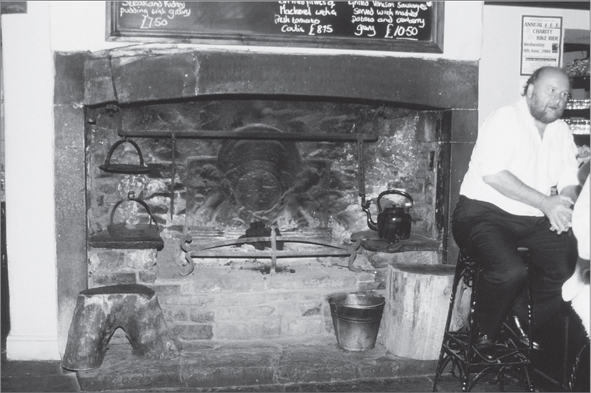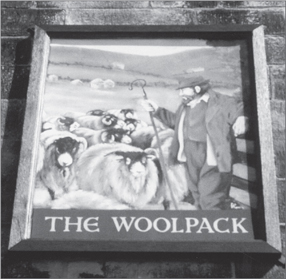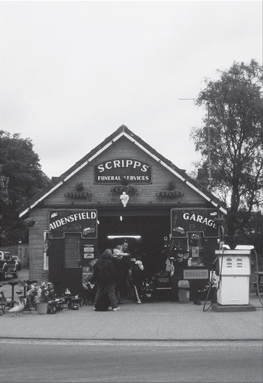3. YORKSHIRE’S TV PUBS
The importance of the local to its regulars and to the community it serves is not open to challenge; it is the very heart of the locality where news is passed on, protests are born and judgements are made.
So-called TV sitcoms and soaps use the pub scene as a means of introducing the members of the cast and of showing their reactions to developments in a story. We soon learn who can be trusted and admired and those who are dishonest and unpleasant. Before long they appear to viewers to be real people; set against a real pub and countryside that viewers can recognise, the impact is both subtle and profound. Every morning following an episode is an opportunity for viewers to talk through the previous night’s happenings and to forecast what will happen next.
Some of the most successful and popular TV series have been set in the Yorkshire landscape and tell tales of Yorkshire folk. The pubs involved have become so famous that they are now visitor attractions for that reason alone; their TV role has created for them an entitlement to be considered historic pubs of Yorkshire.

Some of the cast of Last of the Summer Wine, with Ron, former landlord of the White Horse.
ASKRIGG: King’s Arms Hotel
Askrigg: A1M and A1 to Leeming Bar then A684 west via Leyburn. At Bainbridge turn right; Askrigg c. 1 mile.
John Pratt’s love of horses was to have important consequences for Askrigg. Born locally, he appears to have inherited wealth from his father who was in the coaching business in London. While a student at Cambridge and afterwards he decided to build stables, known as Lodge Yard, in 1752. In front of the stables was a hound pit, where as Master of the Askrigg Harriers he kept the pack of hounds.
On the main street Pratt continued to build: the King’s Arms that dates from the 1760s and the neighbouring handsome Manor House, his own home.
Eighteenth-century Askrigg was a wealthy village and had been for centuries, with a number of small-scale industries, including clock making, brewing and woollen knitting using fleeces from Wensleydale sheep. It had a market charter dating from Elizabethan times; the market cross with its five steps stands next to St Oswald’s Church, only a few yards away from the King’s Arms. Before the turnpike was built on the opposite side of the river Ure the road through Askrigg was used for through traffic, including the coach between Richmond and Lancaster which called at the King’s Arms. As the importance of Hawes grew so Askrigg’s prosperity declined; but the coming of the railway brought a return to its former business activity.

Askrigg village.

The King’s Arms Hotel at Askrigg.

One fireplace at the King’s Arms . . .

. . . and a second fireplace in the parlour.
In about 1800, some years after John Pratt’s death, the ownership of the King’s Arms passed to Joseph Lodge who extended the premises. He built the Assembly Rooms that served as a meeting place for the Askrigg Equitable, Benevolent and Friendly Society founded by Lodge to protect members from poverty arising from sickness and accident. The society is still in existence and continues to meet at the King’s Arms. Lodge’s social conscience was matched by his business acumen, and he set up a brewery behind the King’s Arms and supplied other innkeepers. The brewery seems to have been working for some fifty years.
A number of changes and events took place in the twentieth century, perhaps the most remarkable being the use of the King’s Arms as the Drovers Inn in the TV series All Creatures Great and Small, and Askrigg being selected to represent Darrowby, where James Herriot, Siegfried and Tristan were based. The three rooms used for All Creatures Great and Small were a providential discovery. The producer’s verdict can only have been ‘look no further’. Certainly they were better than any studio set. The bar, which was once a tack room, has its original massive fireplace and a wide range of riding gear, while the other two rooms at front and rear were a restaurant and small bar. The bar is so familiar that it would not be surprising to see James and Tristan arriving for a drink.
Even more recent has been a complete redevelopment of the rear buildings of the pub and Lodge Yard. Together with new buildings, a complete transformation has taken place. Through an archway a charming house, the Dovecot, can be seen on the site of the old brewery. The old stable range has been totally converted into apartments; facing the stables is the hound pit, now an attractive garden.
It is over 250 years since John Pratt started a chain of unlikely events that have continued with the opening of the ‘new’ Lodge Yard in 1999. One can be confident that the changes already made will not be the last.
ESHOLT: The Woolpack
Esholt: A6037 from Bradford to Shipley, then turn right A6038. In about 1½ miles turn right for Esholt.

This pub became famous in Emmerdale, which began its long TV series (as Emmerdale Farm) in 1972. It was 1976 when a new Beckindale was needed and Esholt became a film village. At that time the pub’s name was the Commercial, but a countryside name was thought to be more appropriate, hence the Woolpack, which it has retained.

The Woolpack at Esholt.
Only the exterior of the pub and scenes in the village were ever filmed, so there are no recollections of the bar seen on television. Because the number of weekly episodes of Emmerdale was increased it became essential to build a film set of the interior away from the TV studios; this is located on part of the Harewood House estate near Leeds.
In spite of the Woolpack’s brief life as a piece of scenery it became much loved, as did Esholt, which is one of the stops on TV ‘Soaps Tours’. Coach parties from distant parts such as Cornwall and Sunderland, even from overseas, are regular visitors; the record for the Woolpack was thirty-two coaches in a single day, and of course large numbers of cars bring additional Emmerdale fans. Needless to say, there is a large car park.
Although Esholt today is just a residential village on the outskirts of Shipley and Bradford, it had an industrial past. In the nineteenth century most of the villagers were factory workers employed in the two mills at Esholt, one a woollen mill and the other specialising in the production of worsted. No doubt even earlier there was handloom weaving in the cottages near the pub and the church. Those handloom weavers would be astonished that their village had become familiar to millions of people today.
GOATHLAND: The Goathland Hotel (THE TV AIDENSFIELD ARMS)
Goathland: A64 York to Malton, then left on A169 to Pickering. At Pickering continue on A169 Whitby road. After Saltersgate fork left for Goathland.
Such is the power of TV that popular series using Yorkshire locations create a huge following anxious to visit the places used as a background to the action week by week. Who knows, filming might be going on, and seeing the actors would be a great bonus.
The filming of Heartbeat began at Goathland in 1991 and this series still has over ten million viewers. Based on that figure, a massive number of visitors would be expected to go to the Goathland Hotel and to receive the reply, ‘Yes, we are the Aidensfield Arms’. Of course, the question is obvious, and it was not difficult for the management to analyse the questions that staff were asked most frequently. The result was a leaflet, ‘Heartbeat: Questions Answered’, which was put on sale at the hotel, its proceeds going to charity. In the first two weeks 380 copies were sold – answering visitors’ queries, benefiting charity and helping to maintain the sanity of hotel staff.
Perhaps it is necessary to add that filming is still going on, but not inside the hotel; after five years the film makers built a set of the bar at the studio for ease of filming, and as a convenience for staff trying to carry out their normal daily work in the hotel.
Goathland’s wonderful setting in the middle of the North York Moors National Park made the village a tourist hot spot many years before Heartbeat, with Whitby and the sea nearby. In addition to the walkers and nature lovers already attracted to the area, the opening of the North York Moors Railway from Pickering to Grosmont with a station at Goathland brought even more tourists.

The Goathland Hotel.

Inside the Goathland Hotel.

‘Aidensfield Stores’

‘Aidensfield Garage’.
Of the early days of the Goathland Hotel we know that it was built for a Mr Smailes, who owned the Pier Hotel at Whitby; its licence came as a transfer from the Hare and Hounds, a beer house that was accompanied by 13 acres of land.
The first tenants were John Hill and his family in 1884; two generations of the Hills held the licence until after the Second World War, having bought the hotel in 1923. In the 1880s opening hours were from 6 a.m. to 10 p.m.; all the drinking water had to be carried in buckets on a yoke from a spring below Goathland station. Life was hard, but little luxuries seem to have been cheap – at today’s prices: beer was 1½d a glass, gin 2d a tot and tobacco 3d per ounce.
At that time the Goathland Hotel was the local transport provider, with three horses and three carriages that met all trains at the station. A return ticket to Pickering or Whitby would have cost 15s and coal was carted from the station at 6d per half ton.
The stone-built Goathland Hotel of today with its two bay windows, central doorway and tall stone chimneys on the gable ends looks spacious and comfortable. Saloon bar, lounge bar and restaurant provide ample accommodation and there are eight en-suite bedrooms. Go early at busy meal times to avoid having to wait.
No doubt past generations of Goathland villagers were not surprised to see holidaymakers walking in the lovely countryside, staying at the Goathland Hotel and visiting the village shops. In their wildest dreams they could not have imagined the crowded car parks and coaches unloading parties on TV tours. Still less would they be able to understand why the Aidensfield Arms, the Aidensfield Stores and the Garage and Scripps’ Funeral Services could become such important parts of people’s lives. Why would it be important where the police station is (at a former police station in Otley) or where Gina is today?
Have you been to Goathland yet?
JACKSON BRIDGE: The White Horse
Jackson Bridge: A616 Huddersfield–Sheffield a mile south of New Mill. Fork right down a steep hill.
Everything about Jackson Bridge is steep. Past the White Horse, Scholes Road climbs steeply out of the valley, stone houses with their upper floor windows showing clearly that they were once occupied by handloom weavers. On the opposite side of the mill beck and bridge, houses cling to the hillside; one of these is occupied by a former landlord of the White Horse, Ron Backhouse and his wife Ruth. Had it not been for Ron’s enthusiasm and their warm welcome, TV cameras might never have visited Jackson Bridge and the White Horse.

The White Horse at Jackson Bridge.
Standing by the side of the bridge, its garden washed by the beck, is the pub, traditional in style and purpose-built in 1830. Not, of course, ancient by any measure, but loved and much-visited on account of its regular use as a watering hole by the famous three: Foggy, Clegg and Compo in Last of the Summer Wine. Close to Holmfirth, the location of Sid’s Café and the home of Nora Batty, Ron and Ruth provided just the right atmosphere in the right place for a refreshment stop for the trio on their antics around the countryside. On the hill above the White Horse in a row of stone houses is the TV home of Clegg; next door is the home of Howard and his long-suffering wife Pearl.
The bar and lounge are heavily decorated with hundreds of photographs of the years of filming done here. Ron became a regular member of the cast as the landlord never quite able to bring order out of chaos and often driven to see ‘our heroes’ off the premises.
The White Horse was always a place for charity fund-raising. The annual auction that followed Harvest Festival there was perhaps less spectacular than some of the ideas to raise money. On Boxing Day 1982 Bernard Fish went over the waterfall behind the pub in a barrel and the next year Ron served five steak dinners to customers in 3ft of water in the dam by the bridge. The most ambitious idea was to go by canoe from Jackson Bridge to the Humber Bridge; even if the early part of the journey had to be on foot owing to lack of water, the participants made it in the end.

The interior of the White Horse as featured in Last of the Summer Wine.
It was January 1987 when the first TV outside broadcast for Breakfast TV took place. Where else? At Jackson Bridge, of course – and it was very nearly snowbound.
What existed here 250 years ago? Perhaps only an inconvenient crossing of the beck: certainly not a community as there is today. In 1684, according to the Huddersfield Examiner, a Mr Henry Jackson who owned property at Meal Hill east of the Sheffield road built a new hall at Totties between Scholes and Holmfirth on the west side. To make an easier journey from one house to the other he built a bridge over the beck at his own expense; this became known as Jackson’s Bridge, later Jackson Bridge, where the village and the White Horse were eventually established.
Behind the bar at the White Horse one of the brass plaques says ‘In 1832 on this spot nothing happened’. Perhaps so, but a great deal has happened since.

The Bradford statue (see pages 178–9).













